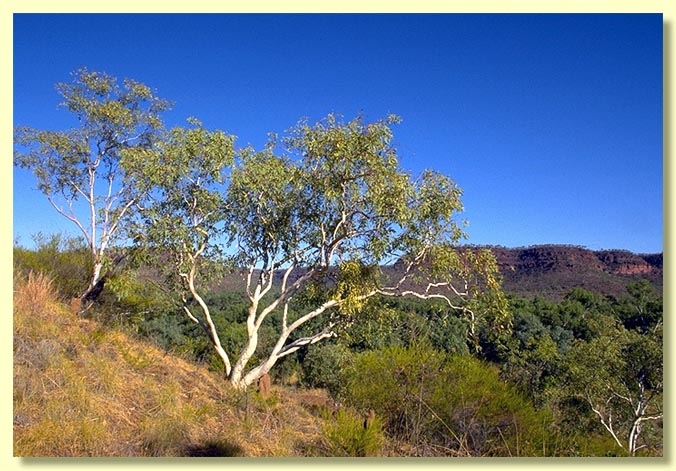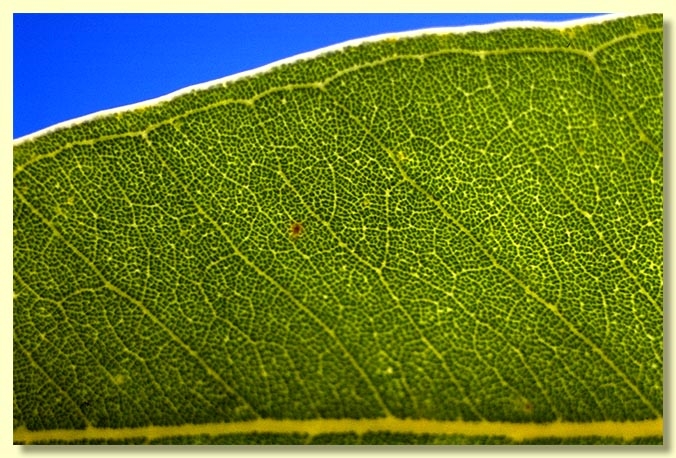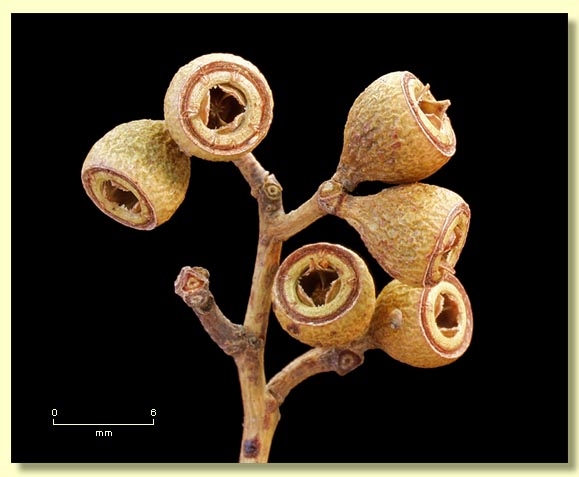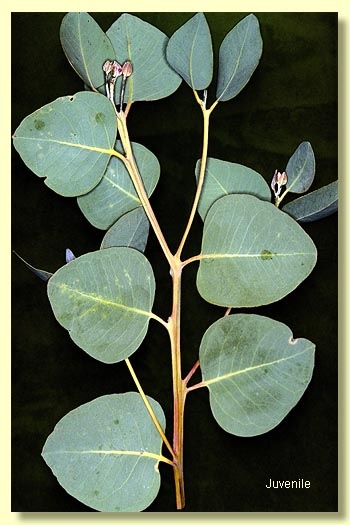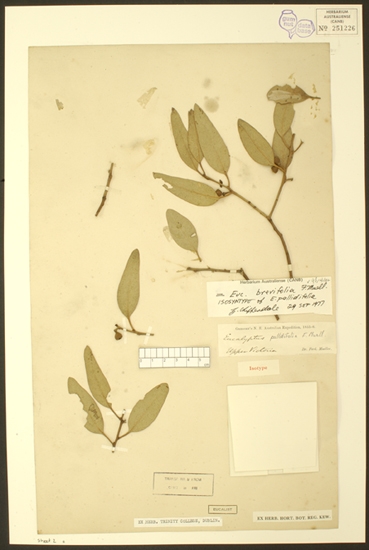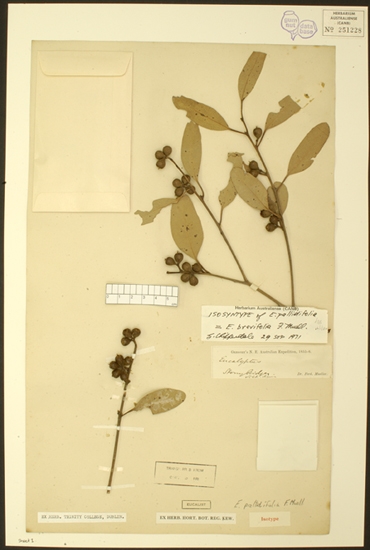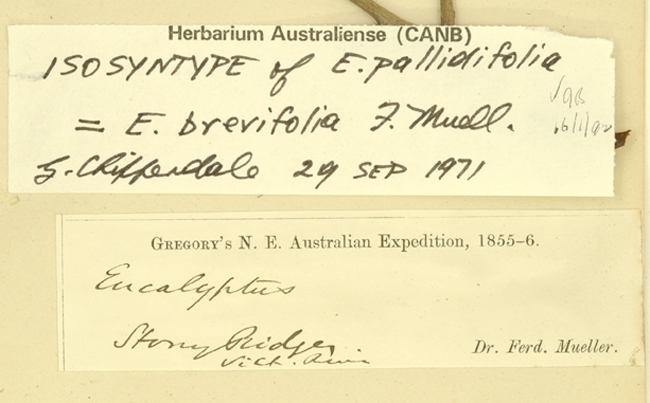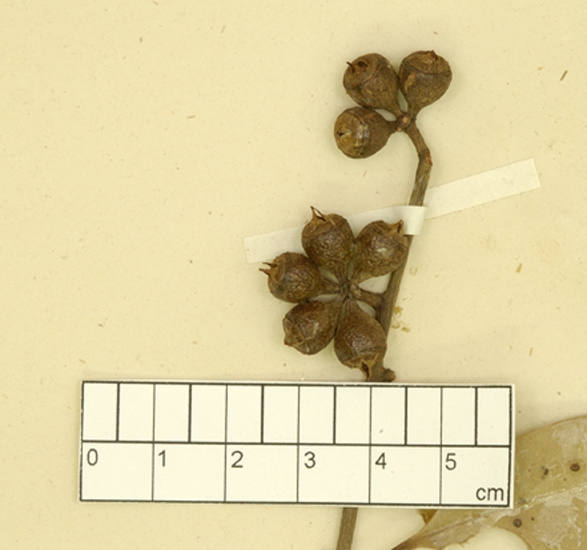Euclid - Online edition
Eucalyptus brevifolia
Eucalyptus | Symphyomyrtus | Platysperma
Eucalyptus brevifolia F.Muell., J. Proc. Linn. Soc., Bot. 3: 84 (1859).
T: Northern Territory. Victoria River, stony ridges, F. Mueller s.n., May 1856; lectotype: K000279690; isolectotype: BRI [AQ103085], MEL231974; fide Bean, A.R., Telopea 12(4): 513-514 (2010).
Eucalyptus pallidifolia F.Muell., Fragm. 3: 131 (1863). T: Upper Victoria River, N.T., 1856, F.Mueller; syn: BRI, CANB, MEL, NSW.
Tree to 10 m tall, sometimes smaller and mallee-like. Forming a lignotuber.
Bark smooth throughout, powdery white, weathering in patches to pink or grey.
Juvenile growth (coppice or field seedlings to 50 cm): stems square in cross-section, glaucous; juvenile leaves always petiolate, alternate, usually ovate to deltoid, rarely almost orbicular, 4–7 cm long, 3–7 cm wide, base rounded to truncate, glaucous.
Adult leaves alternate, petioles (0.8)1.5–2.5 cm long; blade lanceolate to broadly lanceolate to occasionally ovate, 5–11 cm long, (0.9)1.5–2.8(5) cm wide, base tapering to petiole or rounded, margin entire, apex pointed, concolorous, dull, blue-grey to glaucous, side-veins at an acute or wider angle to the midrib, reticulation very dense, intramarginal vein close to margin, oil glands apparently absent or sparse and intersectional.
Inflorescence axillary unbranched, peduncles 0.3–0.9 cm long, buds 7 per umbel, sessile to shortly pedicellate (pedicels 0–0.3 cm long). Mature buds glaucous or non-glaucous, obovoid to ovoid to pear-shaped with the operculum often narrower than the hypanthium at the join, 0.6–0.9(1.1) cm long, 0.4–0.8 cm wide, scar present, operculum rounded to bluntly conical (0.3–0.5 cm long), stamens regularly to irregularly inflexed, anthers oblong, versatile, dorsifixed, dehiscing by longitudinal slits, style long and straight, stigma blunt to slightly rounded, locules 3(4), the placentae each with 6 or more vertical rows of ovules. Flowers white.
Fruit sessile to shortly pedicellate (pedicels 0–0.3 cm long), cup-shaped to barrel-shaped to hemispherical, glaucous to non-glaucous, 0.4–0.8 cm long, 0.6–0.9 cm wide, disc broad, level to sometimes slightly raised, valves 3(4), near rim level or exserted.
Seeds dark brown to yellowy brown, 1.8–2.5 mm long, flattened-ovoid, dorsal surface shallowly reticulate, edge of seed smooth, hilum ventral.
Cultivated seedlings (measured at ca node 10): cotyledons bilobed, often only shallowly indented at the apex; stems square in cross-section; leaves always petiolate, opposite for ca 8 nodes then alternate, ovate, 4–7 cm long, 3–5.5 cm wide, dull, concolorous, grey-green to glaucous.
Flowering has been recorded in March, April, May and August.
A small to medium-sized tree widespread in the Kimberley region of Western Australia and the adjacent Victoria River and northern Tanami district of the Northern Territory. Characterised by smooth powdery white bark, dull leaves and fruit with a broad flat or slightly ascending disc.
Eucalyptus brevifolia belongs in a group of species that are distinguished by having smooth bark, very dense reticulation in the adult leaves and flat, flattened-ovoid, non-toothed, pale yellow-brown to brown seeds with a ventral hilum. The other members of this group are E. kenneallyi, E. umbrawarrensis, E. rupestris, E. confluens, E. leucophloia and E. ordiana.
Within this group, E. brevifolia is separated from E. umbrawarrensis and E. confluens by its dull adult leaves (glossy in E. umbrawarrensis and E. confluens). E. umbrawarrensis is further distinguished by having fruit with a narrow, vertically descending disc. (E. brevifolia has a broad flat to ascending disc.) Likewise, E. leucophloia, E. ordiana, E. kenneallyi and E. rupestris are also separared by their narrow disc.
Within its area of occurrence, E. brevifolia there are other closely related white gums species viz. E. apodophylla, E. cupularis, E. gregoriensis, E. herbertiana, E. houseana, E. mooreana and E. pantoleuca. They are distinguished from E. brevifolia as follows:
Eucalyptus apodophylla and E. pantoleuca are distinguished by having relatively large, opposite leaves in the mature crown (usually >4 cm wide in E. apodophylla and E. pantoleuca but much smaller, usually narrower than 4 cm wide and alternate in E. brevifolia). E. cupularis is distinguished by having long lanceolate adult leaves (usually longer than 10 cm in E. cupularis and less than 10 cm in E. brevifolia). E. gregoriensis and E. pantoleuca are three-budded in each umbel. (E. brevifolia is seven-budded.) E. herbertiana and E. houseana can be separated from E. brevifolia on fruit size, always less than 0.6 cm wide in E. herbertiana and E. houseana but greater than 0.6 cm in E. brevifolia. E. mooreana is easily distinguished by having opposite leaves in the mature crown, always alternate in E. brevifolia.
MORE ABOUT RED GUMS AND OTHER ASSOCIATED GROUPS
Eucalyptus brevifolia: Latin brevi, short and folia, the leaves.

